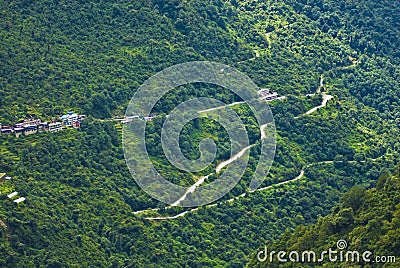 (Picture showing cars on a road in the middle of a debris flow. Picture courtesy of the National Park Service)
(Picture showing cars on a road in the middle of a debris flow. Picture courtesy of the National Park Service)
The first reason why Yellowstone has rapid mass wasting is because of gravity. This force
acts on every object on earth, including Yellowstone ’s
mountains and hills. Gravity causes the colluvium or angular slope material to
slide downward.
 (Diagram showing the effect of gravity on a slope. The gravity causes stress on the slope, which leads to a landslide. Picture courtesy of Google Images)
(Diagram showing the effect of gravity on a slope. The gravity causes stress on the slope, which leads to a landslide. Picture courtesy of Google Images)
Another important factor to
consider in determining why an area has mass wasting is whether the slope is permeable
or impermeable. Impermeable slopes do not absorb water, and therefore do
not have a lot of vegetation. Permeable slopes, like those in Yellowstone, absorb water and are heavily vegetated; they usually lead to slower mass wasting phenomenon like creep. This occurs when the
slope gradually moves downhill as a result of the soil swelling and shrinking
as it gets wet and dries out. This has occurred in Yellowstone ,
causing damage to hiking trails and trees.
 (Example of a permeable hillside. The hillside has a lot of vegetation; showing that the soil absorbs water. Picture courtesy of Google Images)
(Example of a permeable hillside. The hillside has a lot of vegetation; showing that the soil absorbs water. Picture courtesy of Google Images) ( An Example of an impermeable surface. The rock is unable to absorb the water. Picture courtesy of Google Images)
( An Example of an impermeable surface. The rock is unable to absorb the water. Picture courtesy of Google Images) ( A diagram of creep's effect on trees. Picture courtesy of Google Images)
( A diagram of creep's effect on trees. Picture courtesy of Google Images) ( A real life example of creep. Picture courtesy of Google Images)
( A real life example of creep. Picture courtesy of Google Images)Sources:
1. Mass
Wasting Lecture
Life is not a spectator sport. If you're going to spend your whole life in the grandstand just watching what goes on, in my opinion you're wasting your life. See the link below for more info.
ReplyDelete#wasting
www.ufgop.org